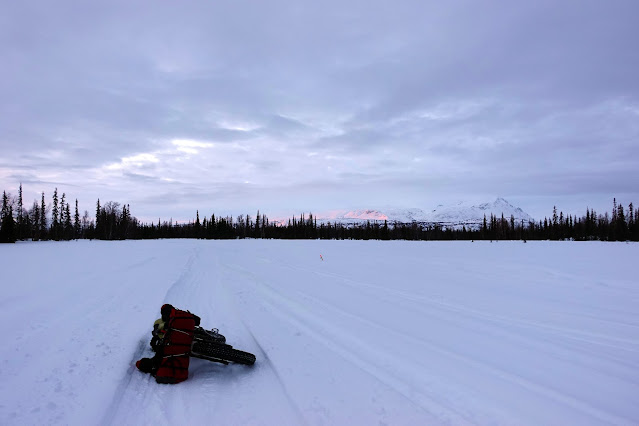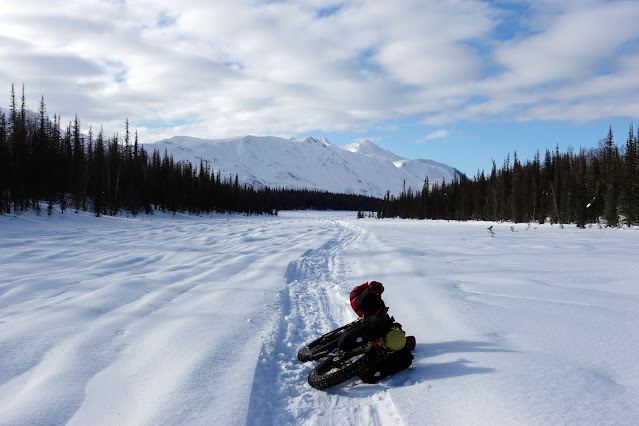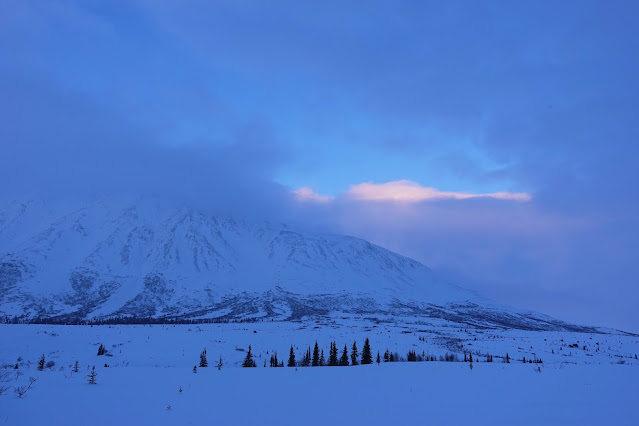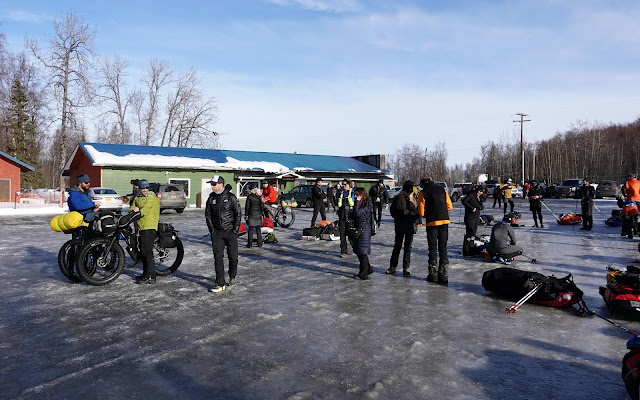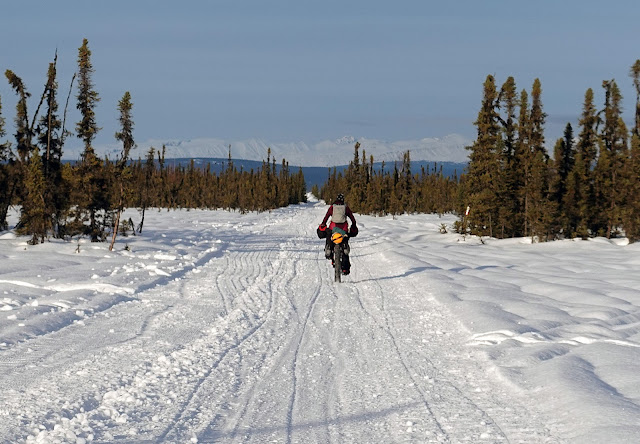Connecting the disparate cities of McGrath, Alaska, and Boulder, Colorado, in this tumultuous post-COVID era proved to be something of an ordeal. A lodge/coffee shop marked the finish line of the Iditarod Trail Invitational 350. The place was nice but disorienting — just so crowded, overflowing with bikes and constant activity. I arrived just after sunset on a Friday evening and set up a nest behind the coffee bar, only to be kicked out as the barista fired up the coffee grinder early the next morning (that I did not see this coming speaks to how befuddled I was after the race.)
 |
| That's the Dalzell Gorge down there! |
I couldn’t secure a spot on a charter plane until Sunday evening, which gave me time to hang around the lodge, drink coffee, put my head back together, and watch Beat efficiently check in and out on his way to Nome. I shared a six-seater plane with Forest, Jason, Jenny, and two pilots. The one-hour trip was the most gorgeous flight I’ve experienced, right at sunset and directly over the trail we’d just spent five-plus days traversing.
 |
| There's Shell Lake! And Denali and Foraker! |
Unfortunately, our bikes couldn’t find flights out until the Wednesday cargo run. Fur Rondy was in full swing and the last available hotel rooms in Anchorage were running $300 a night. Luckily, I’d spent quite a bit of trail time with a local woman named Bobbette, who offered to let me stay at her house even though she and her husband were actively packing to move to Ketchikan two weeks later. My four days in Anchorage were surreal. I seemed to be experiencing March 2020 all over again — but in reverse. I went for painful yet relaxing jogs along the snow-packed yet oddly congested Coastal Trail. I shared indoor space with people I’d only just met. We laughed over dinners and met friends at crowded restaurants that were all of the last restaurants I visited before the pandemic closed everything down. It felt so similar, but instead of shutting down, life was opening up again. It was as though the past two years never happened. It was all too normal. It was strange.
 |
| Betsy on Niwot Ridge. It was a fun day bookended by difficult nights, and it a bit alarming how little of this hike I remember. |
I finally made it home after 2 a.m. Friday, just under a week since I pedaled into McGrath. It had recently snowed and the roads were lined with deep snow berms. This is exactly what my return from Alaska looked like in 2020, except the airport and streets were no longer abandoned, but rather overcrowded, pulsing with anti-masker frustration and road rage. What was the same, though, is that I felt overtaxed and a little culture-shocked. Cognitive dissonance rang in my ears as I collapsed in bed and cried for more than an hour. I’m more of a crier than I used to be; when I really need an emotional release, tears just come out.
But the emotional outburst seemed to sap the rest of my energy. I couldn’t find my bearings for days.
Without looking at the records I keep — Strava, mostly, and other snippets of social media — I couldn’t really recall one thing I did that entire week. According to the records, I had good moments. I hiked Niwot Ridge with my friend Betsy. I tried to relaunch my running, but the toe I likely rebroke during the ITI caused too much agony. I also know I spent a lot of time reading about the war in Ukraine and refreshing Trackleaders to see where Beat was on the Iditarod Trail. I felt isolated in my house.
 |
| Sunrise on March 16 |
My anxiety clamped down to an unmanageable degree. My one, unqualified memory from that week — one that I didn’t reboot by looking back through records — is lying in bed with every muscle clenched as my heart raced, hyperventilating and looking at my hands as they shook. Panic attack. It happened more than once.
Why is my anxiety so bad some days? It’s difficult to pin down, although I think it may partly be a reaction to the typical ebbs of middle age. There’s also likely a role from Graves Disease and the hormonal disruptions that caused even though I was able to bring my thyroid levels back to normal range. My breathing is still strained sometimes, and this is an instant anxiety trigger.
 |
| Sunset on March 19 in a different world. |
There’s also the reality of the modern age, this all-too-knowable Hellscape of war, cultural degradation, and climate change, that weighs heavily on my mind. I acknowledge that my personal position is deeply privileged and I am grateful and happy with most aspects of my life. But I mourn, every day, for the ongoing changes in this beautiful world and the fact that we humans — mean, selfish creatures that we are — are the ones in charge. I also mourn for human suffering. I can’t really help it. Most of my loved ones tell me to look away, stop reading the news, stop Doomscrolling, but I don’t see how my ignorance of important truths will change their truthiness. I also had a falling out with my last therapist that has left me leery of therapy. In short, the therapist was not all that helpful after my Dad died. Also, if I have to hear “be kind to yourself” one more time … (I’m all about self-care, no doubt, but how is this going to do anything for existential despair? It’s like handing someone a bandaid when the bleeding is internal.)
 |
| Photo by Corrine Leistikow |
I believe my March panic attacks were spurred by an irrational fear that I was going to lose Beat, which is less irrational when you take into account he was engaged in a reasonably dangerous activity far away in Alaska. If I had access to medication during these episodes, I absolutely would have taken it, but I’ll be completely honest — I’m so leery about meds and their side effects that I’m unlikely to seek them out during more stable times, which means they’re not available when I destabilize. I will say that right now — mid-April — my mindset has been great, and I can’t recall why I was so upset last month. There’s always the hope that my brain will stay “cured,” but I should know better by now.
I do have one coping mechanism that nearly always works, though — walking.
 |
| Another portrait by Corrine |
While I love other modes of traveling through the world, there’s nothing quite as meditative as moving my body in the most natural, sustainable way of all. During my difficult week at home, I thought about an offer from my Fairbanks friends Corrine and Eric, who had rented several cabins in the White Mountains over the weekend to celebrate their combined March birthdays. The White Mountains are one of my favorite places in the world. They’re also quite far from my home, and an expensive trip no less. But as I looked at a calendar and mulled the logistics, I thought … I could do that.
Corrine and Eric were biking the classic 100-mile loop over four days. They thought I would want to ride my bike too. At first, I made excuses — I’d been through a small amount of hell trying to bring my bike back from McGrath and wasn't keen to box up that beast again. Then Corrine found a friend willing to lend me her bike, so I had to be truthful — really, I’d rather just walk.
Corrine reminded me that there would be long days. One day was close to 35 miles.
“Even better,” I thought.
Corrine expressed concern for the semi-broken toe I had been complaining about.
“Why would I care about my toe?” I thought.
 |
| Here's one where I fell off the trail while darting out of the way of my own friends like a frightened squirrel. |
It didn’t take me long to throw my sled gear together. Much of it was still in a pile from our Christmas trip. I’d dragged a sled all of … 40? … miles during that trip, which was my total sled training for the season. I was still fewer than two weeks removed from cycling the Iditarod Trail and reasonably fatigued from that effort. My legs were still sore and covered in bruises from a multitude of crashes during the race. There were almost endless reasons to consider this trip a bad idea, but as my flight descended into Fairbanks, I caught a song on my iPod that filled my heart with warm fuzzy assurance. Appropriately enough, the lyrics spoke to displacement and desolation — “I Don’t Live Here Anymore” by War on Drugs.
I’m gonna say everything I need to say
Although you’ve taken everything I need away
I’m gonna make it to the place I need to go.
We’re all just walking through this darkness on our own.
In town I purchased at least six days’ of supplies (for a four-day trip, mind you) and spent the afternoon fumbling with sled assembly, repacking my gear, and practicing the sled-drag in my T-shirt in 25-degree weather. Corrine and Eric loaned me their car so I could get an early start the following day. The drive along the Elliot Highway was still bumpy and icy from the Christmas ice storm that wrecked our December trips. But it was bright now, glaringly bright, and springtime warm as I pulled into the Wickersham Dome at 9 a.m.
 |
| Feeling small in big places among the matchstick forest — this to me is the whole, simple yet infinitely complex experience of walking through the Whites. |
What is it about the White Mountains that I love so much? In a dozen years, I’ve logged close to 20 different trips, including seven finishes of the classic 100-mile loop during the White Mountains 100. I’d guess my total mileage on bike and foot in these mountains is well over 1,500. I’ve never even lived in Fairbanks. I’d barely given the region even a passing thought when an acquaintance emailed me about a new race he was organizing, about two weeks before the event, in March 2010.
“Everyone on the roster is from Anchorage and Fairbanks,” Ed wrote. “We need at least one from Juneau.”
 |
| The shadowy limestone jags above Fossil Creek |
I was technically a Juneau resident at the time, but I already had one foot in the door. I’d put in a two-week notice at my newspaper job and secured a temporary spot to live in Anchorage while I figured out my next step. I was still reeling from the dissolution of a long-term relationship nine months earlier and resolved to make big changes in my life. I was going to leave this rainy, isolated place, and I was definitely going to quit endurance racing, the source — I was convinced — of all of my woes. All of the time, all of the energy, so much useless striving.

Still, Ed’s offer was intriguing. With almost no training behind me, I signed up for 100 miles on a bike and recruited a Juneau friend to make the road trip to Fairbanks. We put his old Subaru on the ferry to Haines and spent two days driving across the Yukon and eastern Alaska. He had all of one cassette tape to play on repeat for 12 hours, but at least the weather was blessedly clear. We spent a night in a tent on the frozen Slims River near Kluane Lake, huddled in sleeping bags and listening to wolves howling through the 15-below night. He basically dumped me at Ed’s house — a melodramatic relationship story in itself — and Ed shuttled me to the start of his race, giggling as the outdoor temperature dipped to minus 20 along the Chatanika River.
 |
| Near Moose Creek during my first White Mountains 100 in 2010 — so young, so innocent. |
The 2010 White Mountains 100 handed me my own ass on a frozen platter. I dragged my Surly Puglsey through wind drifts and glare ice, across bumpy aufeis that seemed to go on for miles, into fierce headwinds, over the Cache Mountain Divide and into the breathtaking chill of Beaver Creek, where it was 25 below. In my desperation to reach the cabin, I ignored the deepening chill. My fingers tingled and my entire butt had gone numb. Borealis cabin, the 80-mile checkpoint, was packed to the brim and had become something of a triage center for other frozen racers. I lingered but still got myself out of there, up the brutal pitch of the Wickersham Wall, and to the finish line some 22 hours later. I was completely crushed. And I was … in love?

Twelve years later, as I started up the now-familiar climb rising to the top of Wickersham Dome, my heart filled with this strange yet nourishing emotion. I felt peace, complete and uncomplicated, even as my body balked at the strain — wait, we’re doing this again? Yes, my mind replied. Shut up and sing me to sleep.
I was lying in my bed
A creature void of form
Been so afraid of everything
I need a chance to be reborn
The first day of the trip was fairly uneventful, and in that way perfect. Temperatures hovered in the 20s and the brilliant near-equinox sun let me walk in my base layer for much of it. I slipped into a meditative flow and thought of little beyond each moment as it passed. If another trail user passed, the sudden disruption was so jarring that I usually plunged off the trail into waist-deep snow, including when Corrine and Eric passed on their bikes near mile 11.
 |
| Crowberry cabin |
But I quickly slipped back into flow state. There were lots of hills and my sled was unconscionably heavy, but it was all a small price to pay for this uncomplicated state of mind.
I did strive to make good progress to Crowberry cabin, and despite the difficulties managed to maintain a 3 mph pace for 25 miles. Corrine and Eric had already been there several hours and completed all of the camp chores — gathering and sawing wood, melting snow, even knocking down the poopsicle in the outhouse. They would tease me about choosing to walk just so I could get out of helping with camp chores. This was a justified complaint. I wanted to do my share, really I did, but I will admit it was nice to simply walk all day and arrive at a warm cabin where all I had to do was inflate my sleeping pad and fire up my stove. We’d share stories, read the cabin log, recite the dad jokes from our dinner packets, heat water for hot chocolate and crawl into our bunks at a blissfully early hour. It was, for me, the perfect trip: I had all of the solitude I craved during the day, and good company to share each evening.

The next day was going to be a long one: 34 miles and 3,000 feet of climbing up and over the Cache Mountain Divide. I guessed the distance would take 14 hours and started at sunrise. The morning was gray and breezy. I did not feel strong. The previous day’s effort weighed heavily on my legs. My hips and hamstrings were sore from lack of conditioning. It was enough to tip my mind-body balance farther to the body side, and I spent more time ruminating on fatigue and pain. My sled shoved me down the steep descent into Beaver Creek and I managed to wrench my knee as well.

When Corrine and Eric passed I tried to put on a brave face, but there was an element of “oh shit, what have I gotten myself into?” The slog up the Divide was admittedly, just that. The sled seemed to have gained a hundred pounds overnight. The trail, while still well packed, was coated in a layer of spindrift that was weirdly slippery. Patches of sunlight occasionally broke through the cloud layer, casting silver light on the mountain tops. It was still incredibly beautiful. I reminded myself of this continually while my legs balked, and I’d stop for a break that I justified by taking photos.

I was almost in tears near the summit, though. The stiff breeze had strengthened to near gale force. Similar to my ride into Borealis all of those years ago, I’d neglected to put on more layers, reasoning I was almost there, almost there — and then suddenly I was wracked with shivering. I stopped, turned away from the wind, and added my thick fleece knee warmers, overboots, and a windproof fleece jacket, but the mild hypothermia persisted even when I started moving again. I’d let my core temperature drop too much — I know better by now. But I will admit, the White Mountains have become something of a distant home for me, a place of peace and to a certain degree, security. They’re familiar, and familiarity breeds complacency. But the White Mountains are still very much a real place, very much a wilderness of the Far North, and very much indifferent to my existence, no matter how much I love them back.

There was little I could do at this point but keep moving and hope I found my way to wind protection soon. I knew I wouldn’t find it until the far end of the Ice Lakes, a series of swamps that often hold glare ice. I remembered it being about a mile from the top of the pass to the forested slopes below the Ice Lakes. In reality, it was closer to five miles. It felt like 50. The gale blasted cold powder in my face as I skittered across icy patches, appealing to the universe to please not let me fall on my throbbing knee or my sore hips. My toe, my stupid toe, probably hurt most of all.
Finally, the trail crossed back into the relative protection of trees. After nearly three hours of feeling uncomfortably cold — never in danger, but certainly not happy — my shoulders finally began to settle. I hadn’t shivered the entire time, but my upper body still felt stiff from the aggressive motion. In the distance, the icy atmosphere refracted sunlight, creating vertical rainbows.
The surrounding mountains were still shrouded in clouds, but through the mist, the setting sun cast unique shades of lavender and pink. It was so beautiful, and since I wasn’t cold anymore, I was perfectly content. All of the walking I’d done that day no longer registered in my brain. My legs were still invested in carrying me out of the cold, so they didn’t complain. Even my toe calmed down.
Time surrounds me like an ocean
My memory like waves
Is life just dying in slow motion?
Or getting stronger every day?
 |
| Photo by Corrine Leistikow |
I nearly beat the darkness to Windy Gap cabin, but I did need my headlamp for the last mile. Corrine met me outside and said something about how long it took me to get there. “I still took less than 14 hours,” I retorted — it had been 13 hours and 39 minutes since I left Crowberry. My pace-guessing skills were actually spot on. She clarified that yes, I made good time, but I will admit that I did feel some inadequacy as a walker. Corrine talked about the difficult day that took them seven hours — they also struggled with the headwind. I felt fairly toasted and probably could have passed out right there, but I was glad to enjoy another social evening of bagged dinners and fun conversation.
 |
| Windy Gap cabin |
The wind raged through the night — Windy Gap earns its name — and we woke up to an ongoing gale and a temperature of 10 below. I was trying to get another slightly early start and sat on the porch to heat water for coffee since my stove (MSR XGK) sounds like a jumbo jet about to take off. (Corrine and Eric were content to use the propane canisters left behind by previous occupants, but honestly I just wanted to use up my heavy fuel.) It was actually sort of fun to sit outside in this fearsome weather and watch sunlight spread across the limestone cliffs that surround this canyon.

The wind had shifted enough to become a strong down-canyon tailwind. For the first mile, the trail followed Fossil Creek over a long ribbon of glare ice. I didn’t have great traction from my shoes and had to skitter while my sled bucked and wove. I couldn't generate much heat at this pace, so my shoulders began to quake again. I realized how sore they were from so much shivering the previous day because this motion hurt quite a lot. Ugh. I had started out wearing most of my layers because 10 below with windchill is not warm. But I couldn’t move any faster on the ice.
A big climb out of the drainage — a recent trail reroute to avoid the glare ice and overflow of Fossil Creek — was a welcome respite. Rich morning light enhanced a panoramic view of the mountains. The surrounding hillside was sculpted with sastrugi, itself a compelling work of art. Corrine and Eric passed and again I was alone, drifting back into flow state, the miles slipping away as effortlessly as water.

It was a 20-mile day to Borealis cabin, the classic triage center and final checkpoint of the White Mountains 100. On this day we were all there fairly early and had lots of daylight to burn. The afternoon had become warm enough for outside T-shirts, at least if you could stay out of the wind. I smiled at the memory of a single piece of advice longtime Fairbanks resident Jeff Oatley gave me before the 2010 race — “It’s always cold on Beaver Creek. If you’re cold at Borealis, keep going.” And to be fair, I don’t think I’ve ever had a White Mountains experience where this has not been true.

Sure enough, the temperature plummeted after sunset. By 2 a.m., it was 20 below. I wandered outside and caught a glimpse of the Northern Lights. They were faint, though, not easily photographed. I wanted to hold out for a better display, but even in my expedition park and puffy pants, I started shivering. I was pretty much done with shivering, so I went back inside.
By morning the temperature had dropped to 30 below. Eric managed to keep the cabin warm by restocking the woodstove all night long. I have a sleeping bag that’s comfortable at 40 below, so left to my own devices I wouldn’t have made this effort, but I won’t deny it was a nice service.

I took off only about an hour before Corrine and Eric on this day — I wasn’t in the biggest of hurries. The temperature held below zero but the wind had calmed. Frost collected on my face but I was finally warm. Peace returned. My legs had locked into forever mode, and I was eager to keep walking. I was a little bummed the trip was ending but hopeful I’d see Beat soon.
Beat had been making his way along the Bering Sea coast while I was in the White Mountains. The day I left was the day he had to cross the sea ice — nearly 50 miles of absolute exposure in 35-45 mph winds and temperatures well below zero. An experienced skier who crossed paths with Beat in the opposite direction called this day the most exposed he's ever felt, and this man has climbed remote 5,000-meter peaks in Canada.

Strangely, I did not fret all that much about Beat once I was out on the trail myself, even though his tracker apparently stopped working at the worst possible time and I was barraged with messages from worried friends and family (I would not see any of these messages until later.) It’s not like I had less reason to worry. It is strange, the way our brains operate in perplexing and often useless ways.
Indeed, as soon as I climbed up the Wickersham Wall — which was not nearly as brutal as I remembered, even though my sled had lost hardly a pound since day one — I caught a glimmer of cell phone reception and switched it on. And just like that, all of my flow came crashing down. The security company called because my home alarm had been triggered two days earlier. My mother-in-law was frightened because Beat's tracker had stopped working for a while. Now Beat’s tracker showed he was on the move from White Mountain, less than 80 miles from the finish. But my flight to Nome the following day had been canceled. And the war in Ukraine. And Twitter.
 |
| Chatting with Eric, with the Wickersham Wall in the distance. Photo by Corrine |
And what was I doing? I was still walking, still traversing the gorgeous ridgeline of the Wickersham Dome, still surrounded by an expanse of valleys and domes rippling across every horizon, and my nose was buried in my stupid phone.
Oh, White Mountains, I’m sorry. I am human and flawed. Can you forgive me?
I never took our love for granted
You never left me wanting more
But you’d never recognize me, babe.
I don’t live here anymore.
Doubtlessly I’ll be back — when winter solstice comes around again and these sun-drenched hills are again cast in muted lavender light. I don’t live here; I’ve never lived here. But in these brief connections, I never fail to find lasting grace.

